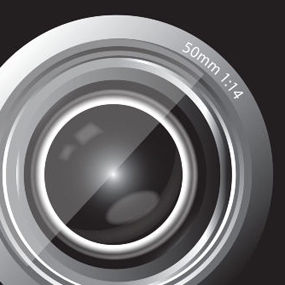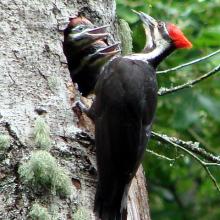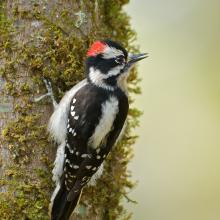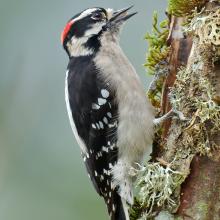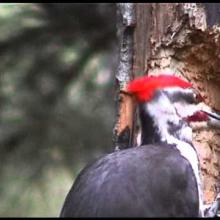

Join BirdNote tomorrow, November 30th!
Illustrator David Sibley and actor H. Jon Benjamin will face off in the bird illustration battle of the century during BirdNote's Year-end Celebration and Auction!
Many woodpeckers chisel out deep cavities in tree trunks in order to lay their eggs and raise their brood. The cavities hollowed out by the birds vary in size, depending on the species of woodpecker. The chamber of a tiny Downy Woodpecker descends about a foot from the opening, while the Pileated Woodpecker may chip out a chamber two feet deep. Both are beyond the reach of a pesky raccoon.
Most North American woodpeckers carve a new nest cavity each spring.
BirdNote celebrates the everyday actions of our listeners and the work of our conservation partners to reverse the alarming decline in North American birds. Together, we can #BringBirdsBack.
BirdNote®
What's Inside a Woodpecker's Nest Hole?
Written by Bob Sundstrom
This is BirdNote.
[Downy Woodpecker excavating sounds https://macaulaylibrary.org/asset/107289]
A roughly circular hole, chiseled by a woodpecker into the face of a tree trunk, is not an unusual sight in nature. What is unusual is seeing what lies beyond the opening.
The hole leads to the interior of the tree, a passageway to the nesting chamber carved below. Inside this private space, layered with wood chips, a pair of woodpeckers will lay eggs and raise a brood.
The chamber must be carved deep enough to accommodate the growing family. Just as woodpecker species vary greatly in size, so do cavities. The chamber of a tiny Downy Woodpecker descends about a foot from the opening.
[Downy Woodpecker call, https://macaulaylibrary.org/asset/107281]
The crow-sized Pileated Woodpecker may chip out a chamber **two feet** deep. These birds usually breed only once each year and typically lay three to five eggs.
Most North American woodpeckers create a new cavity each spring. An aging trunk may reveal a long history of nest holes, deep lineages of woodpecker families.
[Pileated Woodpecker drumming sounds https://macaulaylibrary.org/asset/190889]
For BirdNote, I’m Mary McCann.
BirdNote celebrates the everyday actions of our listeners and the work of our conservation partners to reverse the alarming decline in North American birds. Together, we can #BringBirdsBack.
###
Bird sounds provided by The Macaulay Library of Natural Sounds at the Cornell Lab of Ornithology, Ithaca, New York. Recorded by Wil Hershberger and Francisco Rivas Fuenzalida.
BirdNote’s theme music was composed and played by Nancy Rumbel and John Kessler.
Producer: John Kessler
Managing Producer: Jason Saul
Associate Producer: Ellen Blackstone
© 2018 Tune In to Nature.org April 2018 / 2021 Narrator: Mary McCann
ID# nest-09-2018-04-23 nest-09




